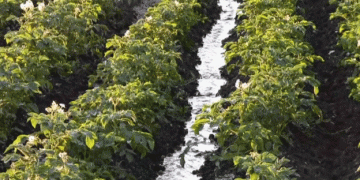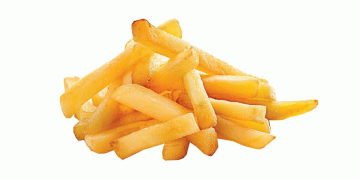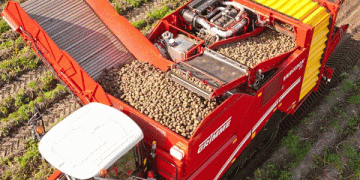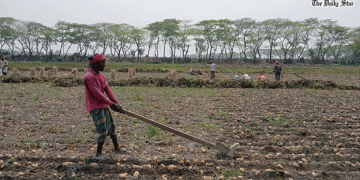The fertilizer prices are at a record level. Still, there is nothing to buy. What can farmers do? Strategies and their consequences
Farmers are currently faced with difficult business decisions. The purchase prices for fertilizer and other business resources explode. Still there is nothing to buy. At the same time, the cost of agricultural production is skyrocketing. Because farmers around the world have to pay record prices not only for fertilizer, but also for pesticides , diesel, electricity as well as for machines and equipment. That is why good advice is expensive or, to put it another way: How can you react to this severe crisis?

In any case, many farmers are very concerned about the development of the fertilizer market . How are they supposed to buy enough fertilizer for the 2022 harvest – and at acceptable prices. Both seem impossible at the moment. Currently, the prices for nitrogen nutriens are three times as high or even higher than in the previous year. And the futures markets for the most important types of nutriens in the USA and the Middle East are showing at least similarly high prices for spring 2022. So no prospect of relaxation.
Urea is currently priced at US $ 780 per tonne at the major import / export ports in the US Gulf for November. For the month of December 820 USD per ton are already being charged and for January to March 2020 the urea price will rise even further: to 840 USD per ton!
You have to pay even higher prices at other important export ports such as Egypt. There they are asking for USD 910 per ton for November and then nearly USD 900 for spring. In any case, these figures show one thing for farmers: there is currently no sign of any easing of the situation on the fertilizer market – at least not until spring 2022.

Wer soll die knappen Dünger bekommen?
Many a farmer will be happy if, in view of the rising prices, has bought and stored his needs early in the year (the same applies to crop protection, by the way). The others have to try to meet their needs at least partially. The fact is that the fertilizer crisis will have a significant impact on crop planning in spring, but above all on the yields of winter cereals and all other crops. Und eine gute Einkaufsstrategie zu entwickeln ist angesichts des fortgesetzten Mangels wichtig. Nur abwarten hilft nicht!
The head of the large US manufacturer CF Industries Tony Will told analysts in a conference call. “Who should get the barely tons that are out there? There will be a lot of unmet demand that will be pent up. We therefore believe that next year earnings will decrease on a global basis. Not because of weak demand, but only because there is not enough fertilizer available. “
The reason for this is not only the lower production of the large manufacturers but also the great uncertainty with which suppliers and dealers are also confronted with regard to further price developments and, above all, with regard to the availability of fertilizers and pesticides.
China and Russia impose export bans
And the supply situation is getting worse: China has banned fertilizer exports until further notice or controls them extremely strictly – but the Chinese are an enormously important exporter of urea and phosphorus all over the world. In addition: Russia, another large exporter, wants to reduce the export of nitrogen fertilizers for at least the next six months in order to curb a further rise in food prices in the Russian domestic market, the Russian Prime Minister said last week.

At the same time, the price of natural gas – which is required to produce nitrogen fertilizer – remains extremely high. And winter is still to come. Many large European and German fertilizer manufacturers such as Yara, SFK Piesteritz or BASF have therefore drastically cut their production.
Natural gas accounts for around 80% of the cost of nitrogen fertilizer production and the prices are four to five times higher than normal, according to the Fertilizers Europe industry group. From their point of view, “the production or sale is not worthwhile” because, despite the record high fertilizer prices , the production costs are not covered. The massive logistics and supply chain problems have also contributed to driving up fertilizer prices.
Fertilize less and have other growing plans?
The prices for nitrogen fertilizers, one of the most important fertilizers for increasing the yields of wheat, maize, rice, rapeseed and other crops, are now at record levels. Of course, an increase in fertilizer prices to three times the previous year’s price is a frustrating thing – and puts a huge strain on farmers’ budgets.
„Bauern werden die höheren Kosten für Düngemittel in Form einer geringeren Pflanzenproduktion und der daraus resultierenden höheren Lebensmittelpreise an die Verbraucher weitergeben“, glaubt Alexis Maxwell, Analyst bei Green Markets, einem Unternehmen von Bloomberg. In the US, for example, high fertilizer prices could mean a smaller corn crop. The yellow grain needs more nitrogen fertilizer than other grains, so farmers could try to cut costs by switching to soybeans or spring wheat, Maxwell said.
Consultants and analysts therefore recommend checking the cultivation plans (where possible) and deciding again where nitrogen (N), phosphorus (P) or potassium (K) are used. For example, corn absolutely needs N to grow properly, but there is an opportunity to reduce P&K a little.

Compared to last year, potash prices are almost two thirds higher.
“The cheaper stuff has long been gone”
Farm managers should take soil samples and review their fertilization plans to see what is important for the coming crop year. The other option is possible changes in the cultivation. Whereby the winter grain and the rapeseed for the next season are already in the ground. So here the die has already been cast.
In the United States, however, things are different. The big question there is: will soybeans, spring wheat and other crops gain more land at the expense of corn because of fertilizer prices? Dan Cekander, a fourth generation soybean and corn farmer from central Illinois, told Bloomberg that he had never seen fertilizer prices so high.
In mid-October, he had considered buying nitrogen fertilizers for $ 880 per tonne – that was 75% above the $ 504 per tonne he paid last year. But he usually does not fertilize until spring, so he decided to hold back on buying it. Just two weeks later, the price shot up to $ 1,320, he said. “The cheaper stuff is gone now,” says Cekander in frustration, who is now changing his usual planting plans.
Corn cultivation is likely to suffer in Europe too – but so will the yields of winter cereals. Farm managers now need to take the time to analyze their costs for 2022 and factor them into crop rotation. In any case, now is the time to develop strategies for 2022, think through various scenarios, and estimate the financial impact of the fertilizer crisis.






